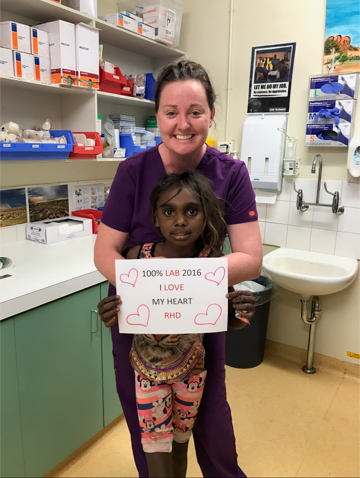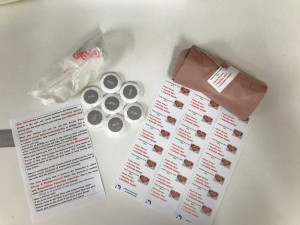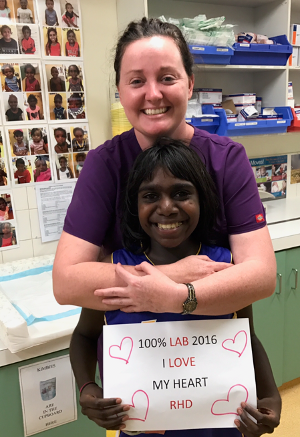Innovation in remote WA community improves skin health for local Indigenous children
A collaborative community approach to improving skin health in the remote Indigenous community of Looma, Western Australia has shown great potential in reducing the risk of acute rheumatic fever (ARF) and rheumatic heart disease (RHD). This approach, according to Remote Area Nurse, Taryn Dukes has dramatically reduced the incidence of skin sores, scabies, and the need to use penicillin injections.

RHDAustralia recently caught up with Taryn and asked her about this initiative at Looma.
Can you tell us a bit more about how this initiative got started?
I was really interested in implementing some of the things I’d seen work well in Gumbulunya in the Northern Territory and then expanding upon it. I wanted to take a holistic approach to health, with special attention to improving skin health. We know that Group A Streptococcus (GAS) is responsible for ARF and RHD and that it’s transmitted easily from person to person, so it’s important to try and stop the transmission by focusing on improving hygiene practices. Through a collaborative effort involving Looma Health Clinic, the school, the local store, and the Derby Shire Environmental Health Team, we were able to significantly improve the skin health of the children in the community.
What role did the school play?
With permission from the school, we had a nurse or Aboriginal health worker attend the school each week and screen the children for skin sores. The staff member then provided health promotion and education on sores, hygiene and dressings. The aim of this screening program was to teach children about hygiene, the proper way to clean sores and how to apply dressings. Each classroom was stocked with a bucket of hotel style soaps and children were encouraged to take them home when needed.
And what service did the local community store provide?
The store managers were very generous. After receiving health information on RHD and skin sores from the clinic, the store managers decided to donate 20kg of washing powder per month for a year. We decided to bundle up the washing powder with hand soaps and information flyers and distribute them as show bags.

How did you distribute the show bags and what did they contain?
Standard practice at Looma clinic dictated that staff do compulsory skin screening on each patient that comes through the door. We thought it would be a good idea to send each client home with a bag of washing powder, hotel soaps, and educational material on skin sores, RHD, GAS, Acute Poststreptococcal Glomerulonephritis (a condition affecting the kidneys), and hygiene. Additionally, we made show bags available in the clinic waiting room for anyone interested.
What role did the Derby Shire Environmental Team play?
Embedded in the 0-5 year old child health checks were compulsory questions regarding housing maintenance. The nursing staff would send referrals on a regular basis to housing and environmental health centres if the patient or staff had concerns. They were really easy to communicate with and played an important role in making sure the houses had working utilities.
Can you tell us a bit more on the education and services that were provided?
Looma Clinic rigorously follows the Kimberley skin health protocol. This means that clinic staff deliver education on skin health and its effects on the body. The staff would sit down and explain to the family why the child needs an injection and why oral medication wasn’t favoured. Although the explanation of skin sores and how they can harm the body can be time-consuming, I believe that education and health promotion are the only way forward.
We also did throat swabbing on all children that presented with sore throats and treatment and followed the CARPA protocol for protection against GAS bacteria.
And what about those who were already diagnosed with ARF and/or RHD, what strategies did you use with them?
When I worked in Gumbulunya, Menzies School of Health Research was working on a research project called Improving Secondary Prophylaxis for Rheumatic Heart Disease. Part of that project involved trialling community driven initiatives encouraging clients to come back regularly for their monthly penicillin injections. At the time, we trialled the use of incentives to increase the uptake of secondary prophylaxis. After three consecutive needles on time, clients would receive a small prize.
We found this worked really well so we tried it in Looma. The kids responded positively and I found they were more likely to come back. Of course, there isn’t a budget for this kind of thing so it was all out of pocket, but to be honest, it wasn’t much money so I didn’t mind.
We also had some internal procedures that helped us manage our recall. We used the Communicare computer system to generate a list of who needed their needles and each Monday we discussed who was due for their injections. All patients that presented for secondary prophylaxis were fast tracked through the waiting room and seen on arrival or as soon as possible. Patients were reminded at the start of the week (Day 21) if they were due. We made magnets that doubled as appointment cards showing the date of their next injection. And finally, we always encouraged patients to come in on a specific day that suited them and offered to set recalls in their phones as a reminder.

Thank you to Taryn Dukes and Monica Frain at Looma Clinic for providing us with these valuable insights and for sharing their successful strategies.
The prevention of ARF and RHD may be undertaken at a number of different levels, from environmental, social, and behavioural through to treatment with antibiotics. While primordial and primary prevention aims to stop the disease occurring in the first place, secondary and tertiary prevention aim to limit the progression of the disease.
The initiative described here is a combination of primordial, primary and secondary prevention and demonstrates what a holistic and community-based approach to fighting ARF and RHD looks like, what it involves, and teaches us the importance of engaging with the community as a whole.
